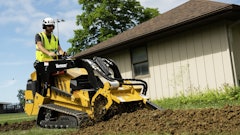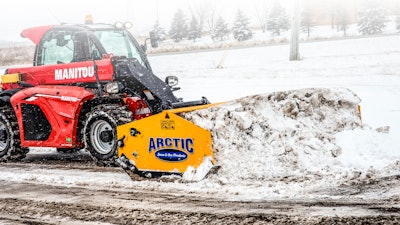
For snow removal contractors, the longer it takes to complete a job, the less profitable it will be. Most business owners understand how important efficiency is key to running a successful snow removal business. To be profitable and take on more jobs, contractors must be able to finish jobs quickly and move on to the next. But that is not always as easy as it sounds.
SnowPRO decided to talk to two of the leading snow pusher manufacturers, HLA Snow and Arctic Snow and Ice, to get insight into the challenges of the snow business, and the keys to efficiency, particularly as it pertains to the choice of pushers.
“When you consider the nature of winter storms, there is no predicting what you will get,” says Dave Peters is the Marketing Director of Arctic Snow and Ice Products and its sister company, Arctic Snow and Ice Control. “It doesn’t just come down, stop, and allow you to plow, salt and go home. It is never quite that easy, and people without hands on experience can never fully appreciate what is being asked of the tools that are available on the market.”
Better Tools Allow for More Contracts
With the right tools, your ability to clear commercial parking lots efficiently and effectively can go a long way toward keeping customers happy and grow your business.
The best way to improve the speed of the job is by upgrading equipment. For many, that means stepping up from a pickup truck with a snowplow to a skid steer or wheel loader with a snow pusher.
“A snow pusher allows contractors to plow more snow at a faster rate,” says Eli Martin, inside sales representative for HLA Snow. “As opposed to a bucket, it can carry more snow and you don’t have to stop and dump the bucket at the end of it. It can carry more snow over long distances, in large amounts. One of the benefits of using a snow pusher is efficiently carrying more snow in one pass than a bucket and carrying more snow than a traditional angle blade.”
“In the past,” says Peters, “time and material contracts were commonplace whereby contractors were actually rewarded for being inefficient. Simply put, the longer they worked, the more they made. Now, fixed-price seasonal contracts have become the norm and efficiency is king. When the industry first introduced off-road equipment and snow pushers, there was a huge improvement over plow trucks.”
Pushers – Versatile Workhorses
When it gets down to business, the pusher serves a variety of purposes, unique to the commercial contractor.
“I’m thinking specifically about shopping malls or even smaller parking lots, where you’re in a situation where the snow has to go all one direction to one end of the lot, as opposed to a typical snowplow, you might end up windowing the snow off to the side,” Martin says. “But a lot of spots where you, as a removal contractor, you’re pretty much bound to put all that snow on one single side in one corner off the lot. So, the box pushers are going to be useful to get the snow there with the least amount of time, as opposed to going back multiple times.”
“Pushers are the workhorses of the commercial snow industry,” says Peters. “Not only can you clear more snow, but they are excellent at back dragging and stacking. In fact, unless you are carting the snow away, you should never see a bucket on site again.”
Since being introduced, pushers have become even more efficient as manufacturers have continued to listen to the marketplace.
According to Peters, “With the new generation pushers, efficiency has reached a whole new level. Using the latest in sectional technology, for example, two to three customers can be serviced in the same time that it would normally take to service one, and with potentially 50% in salt savings. With that type of efficiency and savings, you just went a long way toward paying off your equipment in one season and positioning yourself for remarkable growth.”
But There Are Shortcomings
One of the challenges of clearing commercial parking lots is the imperfections in the concrete, which affect the performance of large pushers.
“While a large pusher can clear a lot of snow quickly, it also leaves a lot behind,” say Peters. “Most lots will have natural depressions or pitted areas where the asphalt has worn away, as well as high spots where the ground has been lifted or a repair was made. A large one-piece horizontal moldboard will teeter on the high points and miss the depressions completely, requiring you to re-plow with a truck or lay down a lot of salt. The same is true of ice and hardpacked snow. The typical pusher is unable to do anything but ride over it.”
He notes that Arctic Snow and Ice Control uses nothing but their own Arctic Sectional Sno-Pushers, which he says are unique in their ability to get under ice and hardpacked snow, while also contouring to surfaces anomalies, including depressions, giving what he deems is a quality scrape that means operators never have to go back over the same area twice.
“We designed and built these pushers because of our frustrations with conventional pushers that required us to re-plow,” Peters says. “Based on the incredible efficiency we attained, we were able to grow our self-performing service business to be the largest in North America, with a fleet of over 450 wheel loaders, skid steers and track machines. It is that simple.”
Finding the Right Snow Pusher
The first thing contractors should look for in a snow pusher is sizing, to ensure there is a good match between their equipment and the pusher itself.
“Every snow pusher manufacturer can provide recommendations for what equipment matches with each snow pusher they sell,” Martin says.
“One of the most important things is matching your pusher to your power unit,” he says. “And it’s very important not to buy a skid-steer-weight pusher when your loader is, you know, three times as heavy as a skid steer. If they do that, the skid steer pusher is probably going to disintegrate by the second snowstorm because they cheaped out and didn’t get the proper size pusher to match the power and the weight of the loader.”
To avoid damaging equipment when encountering obstacles, Martin suggests a snow pusher should also have a spring trip, or similar mechanism. “A spring trip cutting edge on the pusher protects the machine, the pusher and the power unit from damage,” he says.
Martin also recommends HLA’s slim brace design or using a snow pusher without an external brace.
“One thing that I like to draw attention to on the pushers is what we refer to as a slim brace design,” he says. “The pusher’s got a wall and that eliminates the need for an external brace cluttering up the corner inside the pusher, which retains snow and keeps the pusher box clean.”
One thing about today’s manufacturers is that they are all becoming more feature oriented as everyone seeks to design the better piece of equipment
“Being a snow contractor ourselves, we have tried out nearly every type of plow to hit the market,” Peters says of Arctic Snow and Ice Control. “What we have found is that in daylight, in light fluffy snow, over a smooth surface, contrary to what you might assume, there are very few differences in results. The differences start to come when the snow turns heavy or icy, the visibility is reduced, the lot is uneven, or the operator gets into cowboy mode. Those are the times when just about every aspect of the design comes into question.”
Understanding Cutting Edges
Cutting edges, whether rubber, hardened steel, or carbide, are a topic that attracts a lot of attention, with some manufacturers attempting to differentiate themselves based on their edges, even though they may not be particularly unique.
“To some degree, need to select their pusher edge based on their geographical area and climate,” Martin says.
Typically, he prefers a steel edge.
“I don’t often recommend rubber,” Martin says. “Basically, rubber is very good for residential work where there’s cobblestone or sand concrete or something like that. For almost all other applications I prefer steel, just because it’s more durable, it’s going to last longer and do a better job of peeling off packed snow.”
But in some climates, rubber does a better job, he says.
“In geographical areas where the majority of the snow falls, where it’s mild and sticky and wet, a rubber edge can work really well because it’s almost like a squeegee,” Martin says. “You can slide that wet snow off the pavement almost like a squeegee and it works really well in that type of climate. But where it’s consistently quite cold and the snow is lighter, the steel edge will be desirable because it handles higher impacts and lasts longer. Rubber is more prone to getting brittle and breaking.”
Different plowing surfaces and operator training also make a difference.
“Some individuals have gotten used to rubber cutting edges because they have been around longer, but overall, they should only be used on surfaces that require it, or in specific areas like parking decks where rubber edges are required,” says Peters. “For those that want extra durability, carbide might fit the bill and most leading manufacturers offer it as an upgrade. Concrete will certainly wear down a blade much faster than asphalt, and carbide might be appropriate if you are plowing mostly concrete. However, under normal conditions on an asphalt surface, AR400 steel generally works the best and provides the best value. If we find an operator is going through cutting edges at an accelerated pace, some additional operator training may be in order.”
A Variety of Features to Consider
When researching the various manufacturers, we noticed no shortage of features designed to add some measure of efficiency to the life of the contractor. One example for HLA concerns the use of movable side wings.
“There are multiple manufacturers that build plows these days with hydraulic rotating side wings,” says Martin. “That gives you the versatility of a traditional angle blade and a box pusher all in one unit. And you can change the configuration on the fly. The whole plow angles left and right, the end wings rotate, so you can form a box screen ahead. You can plow it straight out with your angle plow, and you can also use it as a back dragging feature where the end wings rotate straight back, where you now have a reverse box for putting snow away from loading docks and so on. That type of hydraulic wing plow is really the go-to for efficiency for a lot of the contractors today.”
In Arctic’s case, their patented Arctic Sectional Sno-Pusher was the product that, when introduced in 2006, captured the attention of the industry and became the original catalyst for much of what is now seen on the market.
One additional feature operators have marveled at since the debut of the Sectional technology was the Slip Hitch mounting system.
“They could now fit their pusher to different machines, connect and disconnect from inside the warm cab with no chains, keep all four tires on the ground for better traction, and the self-leveling drop and go capability allowed beginning operators to plow like a pro,” Peters says. “I think everyone can agree that if your product solves the most problems, you probably have the better product.”
However, Arctic’s approach toward product enhancement has always been to stress practicality over form and feature, and points to its use of nuts and bolts to replace welds and rivets.
“Everything about our pusher is modular,” says Peters. “As a snow contractor, we know how often metal dents, bends, and breaks in the field. For us, the ability to swap out components makes maintenance a piece of cake. What contractor cannot relate to that?”
Innovation – The Key to Efficiency
Looking at the variety of pushers currently available, we wanted to get a sense of how manufacturers approached innovation when it came to pusher design and whether there were key features that should stand out for the contractor, and whether it is possible to take all the best ideas and roll them into one.
HLA has taken technology seriously in their designs to aggressively address the innovation boom. “Like many other firms” Martin says, “we are trying to keep up with the changing technology landscape with innovative features of our own, including something as simple as a small change to a support brace so it collects less snow.”
Arctic took the concept of up and down movement and tried something far removed from the use of springs.
“Our polyurethane mounting blocks were an innovation with multiple benefits, some of them unexpected,” Peters says. “We had to deal with the limitations of springs in a revolutionary way to get the results we needed most. But then we discovered a host of performance and safety enhancements that came along for the ride. This is an example of where innovation is not just an end but a means to another set of ends.”
Seeing a variety of features would seem to suggest that manufacturers by want to borrow the best of the best and combine them into a new design, but that may not be as simple as it sounds.
“You have to be careful when looking at a snow pusher and thinking of it as a collection of features rather than as an integrated system,” Peters says. “For example, we were able to give our moldboards a more aggressive attack angle to roll the snow so that you are able to move a much larger quantity.”
He says that was made possible for two reasons. “Because of the slip hitch, none of the machine’s horsepower was spent on lifting but strictly on pushing. Additionally, we had traction we never had before. Not only did we always have all four tires on the ground, but the quality of our scrape meant the tires would not spin. If we tried that on a different design, the machine would come to a halt with the extra weight of the snow.”
Relating Detail to Overall Value
We wondered how contractors could possibly decide about purchasing the right pusher for their business given all the varied designs on the market. How do they know what works and what doesn’t, and does it speak to the needs of their business?
According to Martin, “Our customers know that we have an established name in Canada and are getting well known in the U.S. as well. We have been around long enough that they know they can count on us for a high-quality product. They also know that we listen to them and always look for ways to give them what they want and need.”
Peters offers four objectives that every contractor should keep at the top of his decision criteria: scraping efficiency, survivability, salt savings and safety.
“Competition is tough, and your choice of pusher can go a long way to determining how you will succeed or fail,” he says. “You cannot afford to spend 2-3 extra hours on a job, spend 50% more salt, waste tens or even hundreds of thousands of dollars on repairing property damage, total your pusher on a light pole, or send your operator to the hospital.”
Peters notes that Arctic invented the Sectional Sno-Pusher in 1995 and used it in their own fleet for 11 years before introducing it to the world. “I can safely say it is proven technology, yet the advice I would give any contractor is do not take my word for it, speak to as many users as you can and ask them about their experiences,” he says. “That is the only way you can truly make an informed decision and truly relate design detail to overall value.”


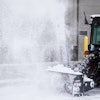

![Doosan Bobcat Wacker Neuson Stack 2ec Js Pb V6e[1]](https://img.greenindustrypros.com/mindful/acbm/workspaces/default/uploads/2025/12/doosan-bobcat-wacker-neuson-stack2ecjspbv6e1.CPyyz8ubHn.png?auto=format%2Ccompress&bg=fff&fill-color=fff&fit=fill&h=100&q=70&w=100)
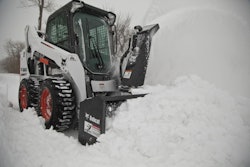
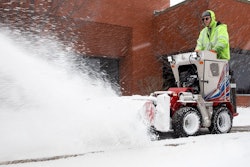

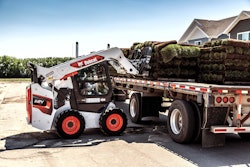

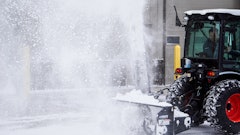

![Doosan Bobcat Wacker Neuson Stack 2ec Js Pb V6e[1]](https://img.greenindustrypros.com/mindful/acbm/workspaces/default/uploads/2025/12/doosan-bobcat-wacker-neuson-stack2ecjspbv6e1.CPyyz8ubHn.png?ar=16%3A9&auto=format%2Ccompress&bg=fff&fill-color=fff&fit=fill&h=135&q=70&w=240)
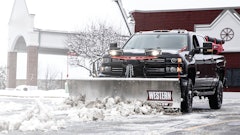
![Gravely Pro Turn Mach One My23 Dsc03139 Edit 1200x800 5b2df79[1]](https://img.greenindustrypros.com/mindful/acbm/workspaces/default/uploads/2025/10/gravely-pro-turn-mach-one-my23-dsc03139-edit-1200x800-5b2df791.BucBnDoN22.jpg?ar=16%3A9&auto=format%2Ccompress&fit=crop&h=135&q=70&w=240)
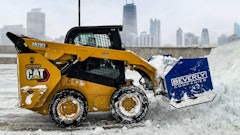
![Kubota Snow ah3 Sgv25ua[1]](https://img.greenindustrypros.com/mindful/acbm/workspaces/default/uploads/2025/10/kubota-snowah3sgv25ua1.bAUoUSziui.png?ar=16%3A9&auto=format%2Ccompress&bg=fff&fill-color=fff&fit=fill&h=135&q=70&w=240)


